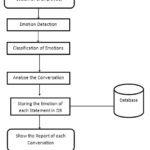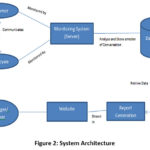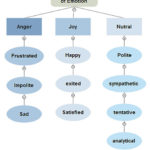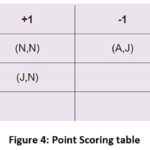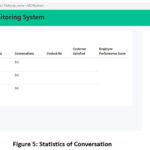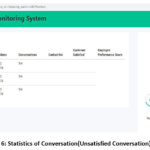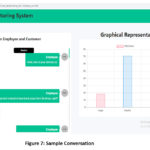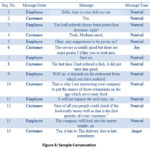Anil S Naik
Department of Information Technology, Walchand Institute of Technology, Solapur, India.
Corresponding Author’s Email: anil.nk287@gmail.com
DOI : http://dx.doi.org/10.13005/ojcst12.04.05
Article Publishing History
Article Received on : 21 Jan 2020
Article Accepted on : 13 Feb 2020
Article Published : 13 Feb 2020
Article Metrics
ABSTRACT:
An Emotion monitoring system for a call-center is proposed. It aims to simplify the tracking and management of emotions extracted from call center Employee-Customer conversations. The system is composed of four modules: Emotion Detection, Emotion Analysis and Report Generation, Database Manager, and User Interface. The Emotion Detection module uses Tone Analyzer to extract them for reliable emotion; it also performs the Utterance Analysis for detecting emotion. The 14 emotions detected by the tone analyzer are happy, joy, anger, sad and neutral, etc. The Emotion Analysis module performs classification into the 3 categories: Neutral, Anger and Joy. By using this category, it applies the point-scoring technique for calculating the Employee Score. This module also polishes the output of the Emotion Detection module to provide a more presentable output of a sequence of emotions of the Employee and the Customer. The Database Manager is responsible for the management of the database wherein it handles the creation, and update of data. The Interface module serves as the view and user interface for the whole system. The system is comprised of an Android application for conversation and a web application to view reports. The Android application was developed using Android Studio to maintain the modularity and flexibility of the system. The local server monitors the conversation, it displays the detected emotions of both the Customer and the Employee. On the other hand, the web application was constructed using the Django Framework to maintain its modularity and abstraction by using a model. It provides reports and analysis of the emotions expressed by the customer during conversations. Using the Model View Template (MVT) approach, the Emotion monitoring system is scalable, reusable and modular.
KEYWORDS:
The Emotion Analysis; Model View Template (MVT); Django Framework; Android Application
Copy the following to cite this article:
Naik A. S. Text and Voice Based Emotion Monitoring System. Orient. J. Comp. Sci. and Technol; 12(4).
|
Copy the following to cite this URL:
Naik A. S. Text and Voice Based Emotion Monitoring System. Orient. J. Comp. Sci. and Technol; 12(4). Available from: https://bit.ly/2Sl710G
|
Introduction
Emotion plays a significant role in successfully communicating one’s
intentions and beliefs. Therefore, emotion recognition has recently become the
focus of several studies. Some of its applications include computer games,
talking toys and call center satisfaction monitoring. In a call centre
environment, emotion analytics is important since ineffective handling of
conversations by the agents can often lead to customer dissatisfaction and even
loss of business. In view of this, we propose an Emotion Monitoring system that
performs a prosodic analysis of call center agent and client conversations.
To construct this kind of system, it is necessary to know some basic
points that can help us in building a robust emotion monitoring system. There
are various types of emotions such as surprise, anger, happiness, fear,
boredom, and sadness and sometimes their no specific emotion related to it. It
is necessary to choose only three emotions that are significant in a call
center environment: Neutral, Joy, and Anger. With these emotions, it is
desirable to look for specific features that can easily distinguish these three
emotions.
Literature survey research reveals that prosodic features are enough
for effective classification of emotions. These features include pitch, energy
and audible/inaudible contours, rhythm, melody, flatness and the like. But
among these features, it is observed that the fundamental frequency of an
utterance is very useful in detecting emotions. There is a very high
inconsistency in recognizing emotions between anger and happiness, two of the
main important emotions in the environment. Often, these emotions are
classified or labeled interchangeably. To extract these features from the
utterance, feature selection methods such as forward selection, and backward
elimination are frequently employed. In, anger, boredom, happiness or
satisfaction, and neutral were the four emotions detected by their systems.
Multivariant discriminant analysis was used and detected that the Median
Derivative of Pitch obtained the highest percentage accuracy.
In implementing the emotion detection system, the Tone analyzer is
used for detecting the emotion. Detected Emotions are classified into three
categories. Using this information, building a system that can detect the
emotions of a call center agent and client during their conversation is
feasible. It is also feasible to build a web application that provides a report
of the performance of each call center agent to their supervisor.1
The development of an emotion monitoring system for call center
agents is significant because both call center agents and supervisors can
benefit from feedback reported by the system. The system described in this
paper can detect and display the emotions of the call center agent as well as
the caller’s emotions is detected at the end of the conversation. This will
help the Employee manage his emotions and handle the conversation properly. The
detected emotions are anger. neutral and joy. For the supervisor/manager in a
call center, the system will also provide the statistics of emotions of call
center conversations for monitoring the Employee’s emotional performance.
Classification of Emotions and Its Process
In the diagram, we see that Dataset is taken as input which is the
conversation between the Customer and the Employee is considered as the call
which is performed using the two Android apps which are connected to Server.
The server is monitoring the Conversation and storing it for Emotion Detection
purpose. In Emotion Detection, emotion is detected for each statement of the conversation.
This Emotion Detection phase is an important part of the project. After Emotion
Detection, the classification of Emotion is done into the 3 categories. Three
Categories are Neutral, Joy, and Anger. This classification is based category
of Emotion. After the classification the next important phase is Analysis. In
which we are using the scoring point technique to calculate the Employee Score
for the Conversation. And it also monitors the last 60% conversation of the
customer for checking Customer satisfaction. When all analysis part is
completed it stores the conversation with the emotion of each statement into
the database. This stored data is used by the manager to check the Employee
performance for conversations performed in a call center. This is checked by
the manager using the Website where the graphical representation is used for
easier understanding.3
Existing System
Emotion plays a significant role in successfully communicating one’s
intentions and beliefs. As a consequence, emotion recognition has recently
become the focus of several studies. Some of its applications include computer
games, talking toys and call center satisfaction monitoring.
In a call center environment,
emotion analytics is important since ineffective handling of conversations by
the employees can often lead to customer dissatisfaction and even loss of
business. In view of this, we propose a real-time emotion recognition system
that performs a prosodic analysis of call center agent and client
conversations.
Previous research reveals that prosodic features are enough for
effective classification of emotions. These features include pitch, energy and
audible/inaudible contours, rhythm, melody, flatness and the like. But among
these features, it is observed that the fundamental frequency of an utterance
is very useful in detecting emotions. There is a very high inconsistency in
recognizing emotions between anger and happiness, two of the main important
emotions in the environment.2
Disadvantages
1. The existing
system is based on the frequency of the voice that not give the appropriate
result of emotion.
2. Their no such
method for checking whether the customer is satisfied or not
Proposed System
As mentioned in the existing system disadvantage, we are going to
implement the proposed system to overcome this. We are going to develop our
system that tracks the Emotion from the conversation for that we are using the
Tone analyzer, and for the second disadvantage, we are classifying the Detected
Emotion into the three categories: Anger, Joy and Neutral. This classification
is used for checking Employee Performance and the last 60% conversation is used
for checking customer satisfaction.
Advantages:
1. Helps manager
to analyze the working behaviour of all Employees
2. Helps manager
to check whether the Customer satisfied or not.
3. It helps the
Employee to check his own performance.
4. It helps the
manager to easily analyze the performance of the Employee.
System Architecture
Customer and employee communicate with each other. This conversation
is monitored by the monitoring system. After storing this conversation scoring
is performed. Each message is assigned a point according to its emotion. In
this way, the conversation is analyzed and emotion and score of the
conversation are stored in the database. Taking all the above points into
consideration data is retrieved from database and report is generated. The
generated report is displayed to the manager or owner with the help of web
application.
Technique or Algorithm
used
A proposed system that we have implemented is mainly for checking
customer satisfaction and employee performance in the call center environment.
For this, we are using the two techniques to achieve these goals. These
Techniques are:
1. First, we are using the classification technique. In this when we
are giving conversion statements as input and detecting emotion. There is a
total of 14 types of emotions. So, classify it into 3 categories as shown in
the fig. This classification helps to detect only the required emotion.4
2. The second technique is to Point Scoring method. In this, we are
using the point table as shown in the above fig. By using this point table, we
are going to calculate the Employee Score for conversation. This score helps to
check the employee Performance. For customer satisfaction, we are monitoring
the last 60% conversion. Point Scoring table plays an important role here.5
Point Scoring table specifies the customer tone, if it equals
“Anger” than values is +2,if it is equals “Joy” than value
is +2 and lastly if it is equals “Neutral” than value is +1.
Modules
The emotion monitoring system for call center employees consists of
the following four modules:
- Emotion Detection
- Emotion Analysis
- Report Generation
- Database Manager & User Interface
Emotion Detection
Conversation performed between Customer and call center employee
(for our project it is considered as the call) is used for Emotion Detection.
Each statement of the conversation is separated as a message from the Customer
and response to it from Employee. Each statement Emotion is Detected by giving
this statement to the IBM Tone Analyzer. This performs the detection task and
gives the result for it. Suppose in any case there is no emotion or tone
dedicated then it goes for the Utterance Analysis. The result of it is the
emotion for that message. This is performed for the entire conversation.7
Emotion Analysis
In Emotion Analysis, the data from the previous is taken i.e. from
the Emotion Detection phase. Input is the conversion with the related emotion
to each message. This emotion detected is classified into three categories:
Anger, Neutral, and Joy. As shown in figure 2. After next is to calculate the
scoring point of Employee. This scored point calculated by using the table as
shown in fig 3. After this from the whole conversation, we are going to analyze
the last 60% conversion of Customers for checking Customer satisfaction.5
This module is responsible for sending information about a certain
utterance such as its corresponding emotion, Employee id, caller id and
timestamp of the utterance to the Database Manager module. This module is also
in charge of the analysis of the emotions of an agent. To produce better
analysis, this module computes the statistics of the emotions found in a
conversation.6
Results and Discussion
We presented an emotion monitoring system for call center agents
which has four modules for Emotion Detection, Emotion Analysis and Report
Generation, Database Management, and User Interface. The tone Analyzer is used
in detecting the emotions during the agent-client conversations. The three
emotions detected by the system are happiness, anger, and neutral. A
user-friendly interface with a professional look that can assist both agents
and supervisors in enhancing client satisfaction was constructed.
Future Enhancement
We are going to take the call recording as input instead of the
Android app. For that, we are using a speaker dissertation which separates call
recording into customer and Employee.
Acknowledgement
The authors acknowledge Walchand Institute of Technology for
providing us the opportunity to work in this research.
Funding
Nil
Conflict of Interest
Nil
References
- Princess Florianne O. Boco, Diana Karen B. Tercias and Kenneth R. Dela Cruz (2010). EMSys: An Emotion Monitoring System for Call Center Agents, University of the Philippines-Diliman,2010.
- C. Busso, S. Lee, S. Narayanan, Analysis of Emotionally Salient Aspects of Fundamental Frequency for Emotion Detection, IEEE Transactions on Audio, Speech, and Language Processing, Vol.17, No.4, pp.582-596, May 2009.
- L. Cen, W. Ser, Z. Yu, Speech Emotion Recognition Using Canonical Correlation Analysis and Probabilistic Neural Network, Seventh International Conference on Machine Learning and Applications, pp.859-862, 2008.
- Asim Smailagic, Daniel Siewiorek, Alex Rudnicky (2013). Emotion Recognition Modulating the Behavior of Intelligent Systems,2013 IEEE International Symposium on Multimedia, pp.378-383,2013.
- L. Devillers, L. Lamel, I. Vasilescu, Emotion Detection in Task-oriented Spoken Dialogues, IEEE International Conference on Multimedia and Expo, pp. 549-552, 2003.
- C.M. Lee, S., Narayanan, Toward Detecting Emotions in Spoken Dialogs, IEEE Transactions on Audio, Speech, and Language Processing, Vol.13, No.2,pp.293-302, March 2005.
- D. Morrison, R. Wang, L. De Silva, W.L. Xu, Real-time Spoken Affect Classification and its Application in Call-Centers, Third International Conference on Information Technology and Applications, 2005.

This work is licensed under a Creative Commons Attribution 4.0 International License.

